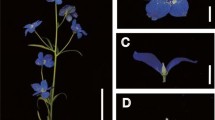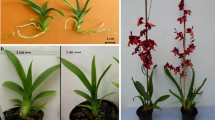Abstract
We have isolated two cDNAs from geranium, PhETR1 and PhETR2. The deduced amino acid sequences of PhETR1 and PhETR2 share 78% and 79% identity with ETR1 from Arabidopsis thaliana respectively. These genes are members of a multigene family and are expressed at moderate levels in leaves, pedicels, sepals, pistils and petals, and at very low levels in roots. PhETR1 and PhETR2 mRNAs are expressed in geranium florets long before they are receptive to pollination and transcript levels remain constant throughout floral development. Message levels of PhETR1 and PhETR2 in pistils and receptacles are unaffected by self-pollination or treatment with 1 μ/l ethylene that induces petal abscission. Our results indicate that the amount of PhETR1 and PHETR2 mRNA is not indicative of the level of sensitivity of geranium florets to ethylene.
Similar content being viewed by others
References
Abeles, F.B., Morgan, P.W. and Saltveit, M.E. 1992. Ethylene in Plant Biology, Academic Press, San Diego, CA.
Altschul, S.F., Gish, W., Miller, W., Myers, E.W. and Lipman, D.J. 1990. Basic local alignment search tool. J. Mol. Biol. 215: 403–410.
Chang, C., Kwok, S.F., Bleecker, A.B. and Meyerowitz, E.M. 1993. Arabidopsis ethylene-response gene ETR1: similarity of product to two-component regulators. Science 262: 539–544.
Chen, H.H., Chang, Y.Y., Shang, F.Y. and Shaw, J.F. 1998a. Molecular cloning and sequencing of a broccoli cDNA (Accession No. AF047476) encoding an ETR-type ethylene receptor. Plant Physiol. 117: 717.
Chen, H.H., Chang, Y.Y., Shang, F.Y. and Shaw, J.F. 1998b. Molecular cloning and sequencing of a broccoli cDNA (Accession No. AF047477) encoding an ERS-type ethylene receptor. Plant Physiol. 117: 1126.
Church, G. and Gilbert, W. 1984. Genomic sequencing. Proc. Natl. Acad. Sci. USA 81: 1991–1995.
Clark, D.G., Richards, C., Hilioti, Z., Lind-Iversen, S. and Brown, K. 1997. Effect of pollination on accumulation of ACC synthase and ACC oxidase transcripts, ethylene production and flower petal abscission in geranium (Pelargonium hort×orum L.H. Bailey). Plant Mol. Biol. 34: 855–865.
Doyle, J.J. and Doyle, J.L. 1990. Isolation of plant DNA from fresh tissue. Focus 12: 13–15.
Evensen, K.B. 1991. Ethylene responsiveness changes in Pelargonium × domesticum florets. Physiol. Plant. 81: 409–412.
Hua, J., Chang, C., Sun, Q. and Meyerowitz, E.M. 1995. Ethylene insensitivity conferred by Arabidopsis ERS gene. Science 269: 1712–1714.
Hua, J. and Meyerowitz, E.M. 1998. Ethylene responses are negatively regulated by a receptor gene family in Arabidopsis thaliana. Cell 94: 261–271.
Hua, J., Sakai, H., Nourizadeh, S., Chen Q.G., Bleecker, A.B., Ecker, J.R. and Meyerowitz, E.M. 1998. EIN4 and ERS2 are members of the putative ethylene receptor gene family in Arabidopsis. Plant Cell 10: 1321–1332.
Jones, M.L. and Woodson, W.R. 1997. Pollination-induced ethylene in carnation. Plant Physiol. 115: 205–212.
Klee, H. and Tieman, D. 1998. The tomato ethylene receptor gene family: It's not easy being a plant. In: K. Cockshull, D. Gray, G. Seymour and B. Thomas (Eds.), Genetic and Environmental Manipulation of Horticultural Crops, CABI Publishing, New York, pp. 63–74.
Knoester, M., Hennig, J., van Loon, L.C., Bol, J.F. and Linthorst, H.J.M. 1997. Isolation and characterization of a tobacco cDNA encoding an ETR1 homolog (Accession No. AF022727). Plant Physiol. 115: 1731.
Lashbrook, C.C., Tiemann, D.M. and Klee, H.J. 1998. Differential regulation of the tomato ETR gene family throughout plant development. Plant J. 15: 243–252.
Lee, S. and Rasheed, S. 1990. A simple procedure for high quality yield of plasmid DNA. Biotechniques 9: 676–679.
Lee, S.A., Ross, S.G. and Gardner, R.C. 1998. An apple (Malus domestica L. Borkh cv. Granny Smith) homolog of the ethylene receptor gene ETR1 (Accession No. AF032448). Plant Physiol. 117: 1126.
Lehrack, H., Diamond, D., Wozney, J.M. and Boedtker, H. 1977. RNA molecular weight determinations by gel-electrophoresis under denaturing conditions: a critical reexamination. Biochemistry 16: 4743–4751.
McGrath, R.B., and Ecker, J.R. 1998. Ethylene signaling in Arabidopsis: events from the membrane to the nucleus. Plant Physiol. Biochem. 36: 103–113.
O'Neill, S.D., Nadeau, J.A., Zhang, X.S., Bui, A.Q., and Halevy, A.H. 1993. Interorgan regulation of ethylene biosynthetic genes by pollination. Plant Cell 5: 419–432.
Payton, S., Fray, R.G., Brown, S. and Grierson, D. 1996. Ethylene receptor expression is regulated during fruit ripening, flower senescence and abscission. Plant Mol. Biol. 31: 1227–1231.
Sakai, H., Hua, J., Chen, Q.G., Chang, C., Medrano, L.J., Bleecker, A.B. and Meyerowitz, E.M. 1998. Etr2 is an ETR1-like gene involved in ethylene signaling in Arabidopsis. Proc. Natl. Acad. Sci. USA 95: 5812–5817.
Schaller, G.E. and Bleecker, A.B. 1995. Ethylene-binding sites generated in yeast expressing the Arabidopsis ETR1 gene. Science 270: 1809–1811.
Schaller, G.E., Ladd, A.N., Lanahan, M.B., Spanbauer, J.M. and Bleecker, A.B. 1995. The ethylene response mediator ETR1 from Arabidopsis forms disulfide-linked dimer. J. Biol. Chem. 270: 12526–12530.
Schultz, D.J., Craig, R., Cox-Foster, D.L., Mumma, R.O. and Medford, J.I. 1994. RNA isolation from recalcitrant plant tissue. Plant Mol. Biol. Rep. 12: 310–316.
Tieman, D. and Klee, H.J. 1999. Differential expression of two novel members of the tomato ethylene receptor family. Plant Physiol. 120: 165–172.
van Altvorst, A.C. and Bovy, A.G. 1995. The role of ethylene in the senescence of carnation flowers: a review. Plant Growth Regul. 16: 43–53.
Wilkinson, J.Q., Lanahan, M.B., Yen, H.C., Giovannoni, J.J. and Klee, H.J. 1995. An ethylene-inducible component of signal transduction encoded by Nr. Science 270: 1807–1808.
Wilkinson, J.Q., Lanahan, M.B., Clark, D.G., Bleecker, A.B., Chang, C., Meyerowitz, E.M. and Klee, H.J. 1997. A dominant mutant receptor from Arabidopsis confers ethylene insensitivity in heterologous plants. Nature Biotechnol. 15: 444–447.
Yau, C.P. and Yip, W.K. 1997. Nucleotide sequence of a full length cDNA encoding an ethylene receptor from rice (Accession No. AF013979). Plant Physiol. 115: 315.
Zhou, D., Kalaitzis, P., Mattoo, A.K. and Tucker, M.L. 1996. The mRNA for an ETR1 homologue in tomato is constitutively expressed in vegetative and reproductive tissues. Plant Mol. Biol. 30: 1331–1338.
Author information
Authors and Affiliations
Rights and permissions
About this article
Cite this article
Dervinis, C., Clark, D.G., Barrett, J.E. et al. Effect of pollination and exogenous ethylene on accumulation of ETR1 homologue transcripts during flower petal abscission in geranium (Pelargonium × hortorum L.H. Bailey). Plant Mol Biol 42, 847–856 (2000). https://doi.org/10.1023/A:1006409827860
Issue Date:
DOI: https://doi.org/10.1023/A:1006409827860




